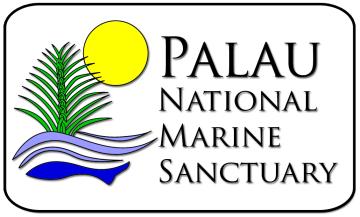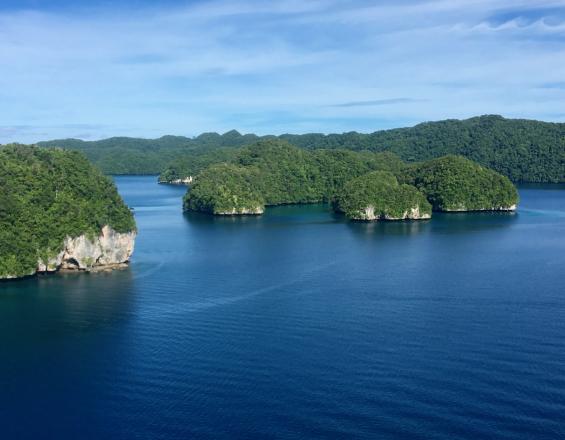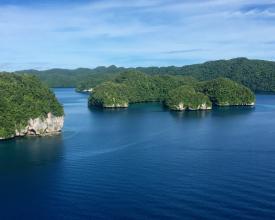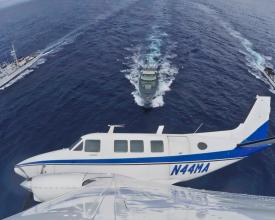
El Santuario Marino Nacional de Palaos: Proteger todo el territorio marino de una nación para garantizar el desarrollo sostenible, mejorar la seguridad alimentaria, impulsar el turismo y enriquecer la conservación de la biodiversidad.

El Santuario Marino Nacional de Palaos (PNMS) fue el primer caso de un país que dedicaba todo su territorio marino a la conservación, suscitando la atención mundial. Las prácticas tradicionales de gestión del dominio integral y la Ley de la Red de Áreas Protegidas (RAP) sentaron las bases para la protección de toda la Zona Económica Exclusiva (ZEE), proclamada en octubre de 2015. La principal innovación es el desarrollo de una lógica holística de desarrollo sostenible: la AMP es el mayor esfuerzo de Palaos para combatir los efectos del cambio climático y la pesca ilegal, no declarada y no reglamentada.
Contexto
Défis à relever
- Proteger una zona de más de 630.000 kilómetros cuadrados de la pesca ilegal, no declarada y no reglamentada, el tráfico de personas y drogas y otras actividades ilegales con recursos limitados.
- Transición de una industria pesquera comercial basada en la exportación a una industria pesquera verdaderamente nacional y sostenible que beneficie a la población y a la comunidad.
- Desarrollar oportunidades de ecoturismo que promuevan y estimulen una industria turística sostenible y respetuosa con el medio ambiente que atraiga a visitantes de alto valor y preocupados por el medio ambiente.
- Involucrar a la comunidad en la protección y conservación de los recursos medioambientales.
Ubicación
Procesar
Resumen del proceso
Bloques de construcción
Desarrollar un modelo de gestión basado en los conocimientos tradicionales
Palaos tiene una larga historia de gestión pesquera. Durante generaciones, los jefes tradicionales han prohibido la pesca en zonas de arrecifes vulnerables, lo que se conoce como "bul", para proteger tanto la biodiversidad como los medios de subsistencia y la seguridad alimentaria de su pueblo. En estos tiempos modernos, está ampliamente aceptado que "la pesca de captura marina tiene impactos directos no sólo en las especies objetivo del mercado, sobre todo el atún, sino que también puede tener grandes impactos en una serie de especies capturadas incidentalmente, algunas de las cuales son particularmente vulnerables a la sobreexplotación y pueden degradar directamente el hábitat y tener amplios efectos indirectos o colaterales en la estructura y los procesos de la comunidad".
Utilizando este método tradicional de conservación, Palaos ha creado un enfoque de gestión de "todo el dominio", desde la cresta hasta el arrecife y más allá, cuyo componente más ambicioso es el Santuario Marino Nacional de Palaos. A medida que Palaos avanza en la aplicación del PNMS, el concepto de Bul se mantiene en la vanguardia de todos los procesos.
Factores facilitadores
- Apoyo abrumador de la comunidad debido a los conocimientos y prácticas tradicionales de los Bul.
- Reconocimiento de la importancia de las prácticas tradicionales por parte del Gobierno nacional.
- Apoyo mundial al uso de prácticas tradicionales para orientar la formalización de la conservación.
Lección aprendida
- Conseguir el apoyo de la comunidad en una fase temprana del proceso fue crucial para aprobar la legislación y poner en marcha la AMP.
- Buscar asociaciones duraderas con organizaciones y gobiernos que reconozcan los valores de la importancia de la tradición, la conservación liderada por la comunidad y la protección del medio ambiente.
Establecer un mecanismo de financiación sostenible
También es novedoso el sistema de financiación del Santuario: en virtud de la ley que lo crea, todos los turistas deben pagar una Tasa Ambiental del Paraíso Prístino (PPEF), que se utilizará para garantizar la vigilancia, el cumplimiento de la ley y la administración necesaria del PNMS.Palaos está realizando un gran esfuerzo para complementar estos ingresos anuales previstos de 1,5 millones de dólares con contribuciones de países socios y amigos. Palaos está recaudando estos fondos y estableciendo un Fondo de Dotación para el Santuario, en el que se depositarán las contribuciones.
Gran parte de esta financiación adicional se destinará al establecimiento de un programa integral de vigilancia y control para hacer cumplir la ley. Este esfuerzo de vigilancia reforzada tiene como componente crítico la cooperación transfronteriza continuada y ampliada en la región de Micronesia con los vecinos y socios principales, Estados Unidos, Japón, Australia y la República de China, Taiwán.
Factores facilitadores
-El apoyo de los visitantes a esta tasa es importante para el éxito de esta iniciativa: Palaos debe dirigirse a visitantes que comprendan que una tasa adicional para proteger el medio ambiente de Palaos redunda en beneficio de todos.
-La cooperación de la industria también es esencial. Palaos está trabajando con sus aerolíneas y agencias de viajes para poner en marcha la recaudación de esta tasa.
Lección aprendida
- Las naciones soberanas que deseen establecer mecanismos de financiación creativos para la conservación del medio ambiente u otros fines deben ser conscientes de los efectos dominó en otros sectores y partes interesadas, pero también deben ser conscientes de sus derechos a aplicar estos mecanismos en la comunidad mundial.
Importancia de las asociaciones para desarrollar la capacidad de vigilancia y aplicación de la ley
El éxito del Santuario Marino Nacional dependerá en gran medida de la calidad de su vigilancia marina y de su aplicación. Como Pequeño Estado Insular en Desarrollo (PEID), Palaos carece de los recursos necesarios para patrullar adecuadamente sus aguas. A lo largo del proceso de desarrollo e implementación del PNMS, Palaos ha buscado asociaciones activas con otras naciones, ONG y proveedores de tecnología para desarrollar y financiar una estrategia integral de seguimiento, control y vigilancia. Palaos espera ahora numerosas contribuciones a su capacidad de vigilancia y aplicación en los próximos meses.
Factores facilitadores
- Relaciones preexistentes
- Conocimientos complementarios de socios específicos
- Colaboración de los países vecinos en la aplicación de la normativa transfronteriza
Lección aprendida
-El desarrollo de una estrategia clara con un calendario, recomendaciones y presupuesto es esencial para desarrollar un régimen eficaz de vigilancia y aplicación de la ley en el ámbito marítimo.
- Con una estrategia clara, la búsqueda de socios eficaces resulta más factible.
Impactos
El anuncio del PNMS ha demostrado, con gran atención internacional, cómo las áreas protegidas no sólo integran la biodiversidad en el sector del cambio climático, sino que también sirven como componente fundamental de las estrategias para proporcionar y garantizar vías de desarrollo sostenible para los pequeños Estados insulares a través de asociaciones duraderas y perdurables. El Santuario es una de las iniciativas de conservación oceánica más ambiciosas del mundo, cuyo objetivo no es sólo proteger los recursos marinos de Palaos, sino también las poblaciones mundiales de atún, gestionando el 80% de la AMP como "zona de exclusión de capturas".
Palaos es pionero en reconocer que su economía depende por completo del mantenimiento de su base de recursos naturales, y en llevar esto a la práctica. En el futuro, se prevé la creación de nuevas oportunidades de empleo gracias al ecoturismo y el consiguiente aumento del nivel de vida, la recuperación de las poblaciones de peces y los arrecifes gracias a la reducción de la pesca, y la garantía de la seguridad alimentaria para la población de Palaos y sus visitantes. Entre los efectos más inmediatos de la aprobación de la legislación sobre el PNMS figuran la protección de todos los mamíferos marinos, tiburones y rayas en la ZEE de Palaos, así como un medio más eficaz de perseguir a los buques de pesca INDNR debido al endurecimiento de los requisitos, las sanciones y las multas de la legislación sobre el PNMS.
Beneficiarios
Beneficiarios directos:
- La población de Palaos
- Operadores turísticos
- Visitantes
Beneficiarios indirectos:
- Toda la región del Pacífico se beneficiará (efecto indirecto)
- Otros países en proceso de creación de AMP pueden aprender de los éxitos y fracasos de Palaos.

